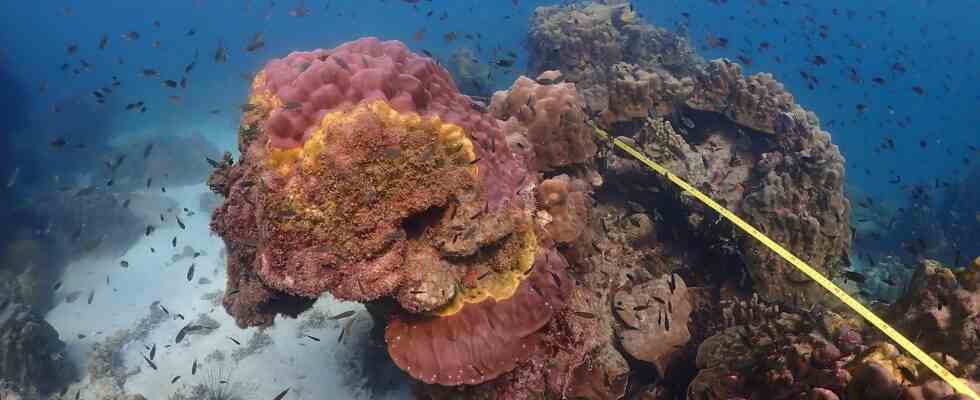Status: 01/20/2023 11:29 am
More and more corals in Thailand are showing an unusual yellow discoloration. But what looks like a beautiful play of colors is one of the most dangerous coral diseases in the world. And science has no cure.
Marine scientist Lalita Putchim dives over a coral reef. Some corals are yellow in color. She takes photos, measuring the size of the discoloration with a ruler. Because the corals are infected – they have yellow band disease. Most people don’t even notice the disease. “Many people are aware of the problem of coral bleaching, but most people think of a yellow discoloration as simply the yellow color of the coral.”
Putchim regularly examines the corals and measures how far the disease has spread.
Image: Department of Marine and Coastal Resources, Thailand
All infected corals die
Putchim first sighted the discolored corals during a routine dive in December 2021. The infection spreads across the coral tissue like a yellow band, giving it the name Yellow Band Disease. “We found that all corals that become infected die,” says Sarawut Siriwong, dean of the Faculty of Maritime Technologies at Burapha University in Thailand.
Yellow band disease is one of the six most dangerous coral diseases worldwide. Possible causes: rising sea temperatures as a result of climate change, overfishing and ocean pollution. According to Siriwong, the warming of the seas is also reflected in the increasing incidence of coral diseases. While coral bleaching used to occur every four to five years, it is now seen up to twice a year in Thailand. But the expert also has hope: “On the other hand, we believe in the ability of corals to adapt.”
Bacteria are the cause
The causative agents of the infection are so-called vibrobacteria, which can also cause diseases in humans. Vibrobacteria, often called vibrios, are found in freshwater and saltwater worldwide. There are more than a hundred different types. “Vibrio cholerae”, the bacterium that causes the diarrheal disease cholera, is particularly well known. Once infected with the vibrobacteria, corals have no chance of surviving. The infection leads to reduced fertility and tissue death.
Worldwide occurrence
Yellow band disease has been known to researchers for almost three decades. Infected corals were first reported in the Caribbean in the 1990s. The local, highly contagious variant is called Caribbean Yellow Band Disease and affects reef-building coral species. In Thailand, yellow band disease was first detected in Chon Buri on the Gulf of Thailand coast. The variant also appeared in countries such as Indonesia or the Philippines. Today, 19 reefs are affected in Thailand, 18 reefs in Chon Buri and one reef in Surat Thani province.
However, Dean Siriwong warns against panic: “Less than five percent of the coral reefs in the Gulf of Thailand are affected by coral diseases. So it is currently only a very small problem.” Despite the still small extent, intensive research is being carried out into yellow band disease. Infectious diseases are among the main causes of the global decline in coral populations.
Climate change also plays a role
However, corals are endangered worldwide due to a wide variety of factors. This becomes clear using the example of the Caribbean: half of all reef-building corals have died there since the 1970s. Corals are delicate creatures. They can experience stress and are then more prone to illness. For example, by rising sea temperatures caused by global warming.
In addition to heat stress, there are other non-biological stress factors such as ultraviolet radiation, sediments or pollutants. But biological influences such as bacteria, fungi or viruses also trigger diseases. Once stressed, the coral is vulnerable to other stressors and infectious diseases. As a result, coral diseases could contribute significantly to the disappearance of remaining reef habitats over the next decade.
hope for healing?
To date, no cure has been found for yellow band disease, although it has been known for over 30 years. “We don’t yet understand the mechanism of the connections, how the disease makes contact,” explains Siriwong, who is a specialist in coral reef ecology and marine biology.
Although the bacteria of the variant discovered in Thailand have a high genomic similarity to the bacteria in the Caribbean, the outbreak rate is different: While the researchers in Florida assumed growth of no more than three centimeters per month, in Thailand it was between, depending on the coral species one to ten centimeters a month, according to Putchim.
An affected coral can infect an entire colony.
Image: Department of Marine and Coastal Resources, Thailand
research on prevention
But every outbreak offers a chance for new insights. In Thailand, too, researchers are trying to mix corals with different genotypes and test this on the reefs.
Research published in 2022 shows that mixing genotypes can promote disease resistance in Acropora cervicornis, also known as small-polyped stony coral. This type of coral is often used to restore reefs. In this way, the corals could at least be helped preventively.
“Do not disturb”
Since no healing options are known, the local scientists are focusing on protecting the coral reefs. Removing the infection would be too cumbersome and would damage too much. Because the affected corals are sometimes two to three meters in size. Instead, authorities and universities are working to sensitize visitors and locals to the topic. “If everyone recognizes the diseases and we are informed early on, we can deal with them,” explains Putchim.
Social media also plays an important role in this. The helpers use social networks to monitor infected reefs and draw public attention to the problem. According to Siriwong, the most effective way to protect the coral reefs is: “Go there and enjoy just looking at them. But whatever you do, try not to disturb the coral reefs any further.”
Thailand: Coral death in the snorkeling paradise
Jennifer Johnston, ARD Singapore, 20.1.2023 8:06 a.m

